Toyota Grand Highlander (AS10) 2024 Owners Manual / When trouble arises / Steps to take in an emergency / If your vehicle overheats
Toyota Grand Highlander (AS10): If your vehicle overheats
The following may indicate that your vehicle is overheating.
- The engine coolant temperature
gauge is in the red zone or a loss
of engine power is experienced.
(For example, the vehicle speed does not increase.)
- "Engine Coolant Temp High Stop in a Safe Place See Owner's Manual" is shown on the multi-information display.
- Steam comes out from under the hood.
Correction procedures
1. Stop the vehicle in a safe place and turn off the air conditioning system, and then stop the engine.
2. If you see steam: Carefully lift the hood after the steam subsides.
If you do not see steam: Carefully lift the hood.
3. After the engine has cooled down sufficiently, inspect the hoses and radiator core (radiator) for any leaks.
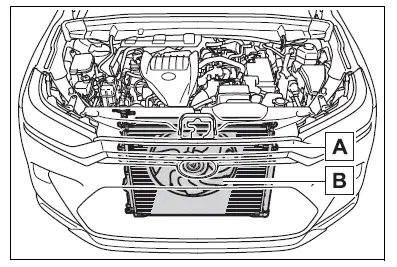
- Radiator
- Cooling fan
If a large amount of coolant leaks, immediately contact your Toyota dealer.
4. The coolant level is satisfactory if it is between the "MAX"/"FULL" and "MIN"/"LOW" lines on the reservoir.
Engine
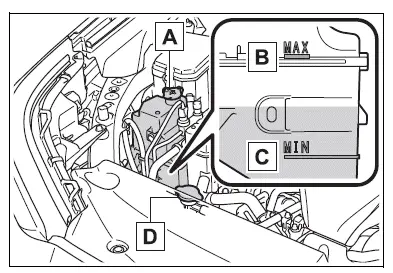
- Reservoir
- "MAX" line
- "MIN" line
- Radiator cap
Intercooler
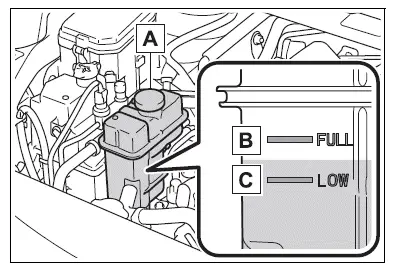
- Reservoir
- "FULL" line
- "LOW" line
5. Add coolant if necessary.
Water can be used in an emergency if coolant is unavailable.
Engine
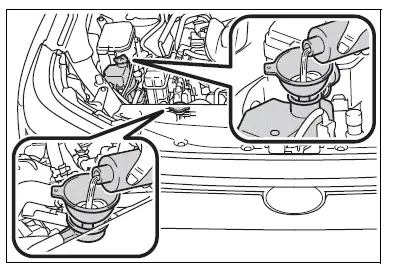
Intercooler
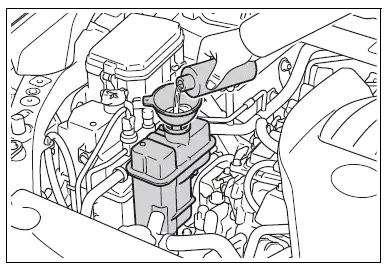
6. Start the engine and turn the air conditioning system on to check that the radiator cooling fan operate and to check for coolant leaks from the radiator or hoses.
The fan operate when the air conditioning system is turned on immediately after a cold start. Confirm that the fan is operating by checking the fan sound and air flow. If it is difficult to check these, turn the air conditioning system on and off repeatedly.
(The fan may not operate in freezing temperatures.)
7. If the fan is not operating: Stop the engine immediately and contact your Toyota dealer.
If the fan is operating: Have the vehicle inspected at the nearest Toyota dealer.
8. Check if "Engine Coolant Temp High Stop in a Safe Place See Owner's Manual" is shown on the multi-information display.
If the message does not disappear: Stop the engine and contact your Toyota dealer.
If the message is not displayed: Have the vehicle inspected at the nearest Toyota dealer.
WARNING
■When inspecting under the hood of your vehicle
Observe the following precautions.
Failure to do so may result in serious injury such as burns.
- If steam is seen coming from
under the hood, do not open the
hood until the steam has subsided.
The engine compartment may be very hot.
- Keep hands and clothing (especially
a tie, a scarf or a muffler)
away from the fan and belts.
Failure to do so may cause the hands or clothing to be caught, resulting in serious injury.
Also, it may operate for several minutes even after the engine switch is turned off.
- Do not loosen the radiator cap
and the coolant reservoir caps
while the engine and radiator
are hot.
High temperature steam or coolant could spray out.
NOTICE
■When adding engine coolant
Add coolant slowly after the engine has cooled down sufficiently.
Adding cool coolant to a hot engine too quickly can cause damage to the engine.
■To prevent damage to the cooling system
Observe the following precautions:
- Avoid contaminating the coolant with foreign matter (such as sand or dust, etc.).
- Do not use any coolant additive.
Similar pages:
Switches
Driving position memory switches*
Outside rear view mirror switches
Door lock switches
Power window switches
Window lock switch
"ODO TRIP" switch
Instrument panel light control switches
Automatic High Beam switch
Heated steering wheel switch*
Power back door switch
*: If equipped
Met ...
Steering wheel
Adjustment procedure
1. Hold the steering wheel and
push the lever down.
2. Adjust to the ideal position by
moving the steering wheel
horizontally and vertically.
After adjustment, pull the lever up
to secure the steering wheel.
WARNING
■Caution while driving
Do not adjust the steering wheel
wh ...


